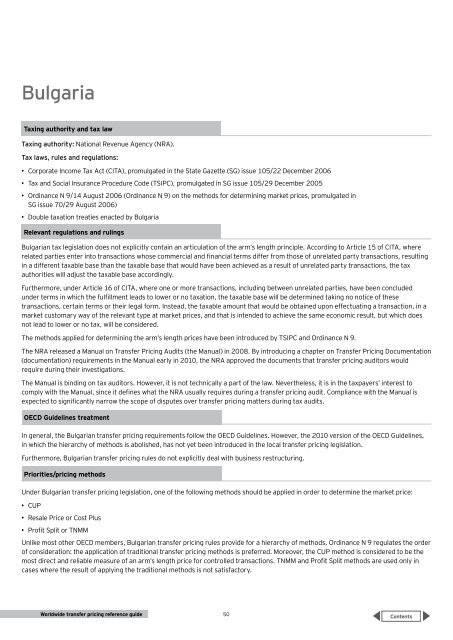Worldwide transfer pricing reference guide 2014
You also want an ePaper? Increase the reach of your titles
YUMPU automatically turns print PDFs into web optimized ePapers that Google loves.
Bulgaria<br />
Taxing authority and tax law<br />
Taxing authority: National Revenue Agency (NRA).<br />
Tax laws, rules and regulations:<br />
• Corporate Income Tax Act (CITA), promulgated in the State Gazette (SG) issue 105/22 December 2006<br />
• Tax and Social Insurance Procedure Code (TSIPC), promulgated in SG issue 105/29 December 2005<br />
• Ordinance N 9/14 August 2006 (Ordinance N 9) on the methods for determining market prices, promulgated in<br />
SG issue 70/29 August 2006)<br />
• Double taxation treaties enacted by Bulgaria<br />
Relevant regulations and rulings<br />
Bulgarian tax legislation does not explicitly contain an articulation of the arm’s length principle. According to Article 15 of CITA, where<br />
related parties enter into transactions whose commercial and financial terms differ from those of unrelated party transactions, resulting<br />
in a different taxable base than the taxable base that would have been achieved as a result of unrelated party transactions, the tax<br />
authorities will adjust the taxable base accordingly.<br />
Furthermore, under Article 16 of CITA, where one or more transactions, including between unrelated parties, have been concluded<br />
under terms in which the fulfillment leads to lower or no taxation, the taxable base will be determined taking no notice of these<br />
transactions, certain terms or their legal form. Instead, the taxable amount that would be obtained upon effectuating a transaction, in a<br />
market customary way of the relevant type at market prices, and that is intended to achieve the same economic result, but which does<br />
not lead to lower or no tax, will be considered.<br />
The methods applied for determining the arm’s length prices have been introduced by TSIPC and Ordinance N 9.<br />
The NRA released a Manual on Transfer Pricing Audits (the Manual) in 2008. By introducing a chapter on Transfer Pricing Documentation<br />
(documentation) requirements in the Manual early in 2010, the NRA approved the documents that <strong>transfer</strong> <strong>pricing</strong> auditors would<br />
require during their investigations.<br />
The Manual is binding on tax auditors. However, it is not technically a part of the law. Nevertheless, it is in the taxpayers’ interest to<br />
comply with the Manual, since it defines what the NRA usually requires during a <strong>transfer</strong> <strong>pricing</strong> audit. Compliance with the Manual is<br />
expected to significantly narrow the scope of disputes over <strong>transfer</strong> <strong>pricing</strong> matters during tax audits.<br />
OECD Guidelines treatment<br />
In general, the Bulgarian <strong>transfer</strong> <strong>pricing</strong> requirements follow the OECD Guidelines. However, the 2010 version of the OECD Guidelines,<br />
in which the hierarchy of methods is abolished, has not yet been introduced in the local <strong>transfer</strong> <strong>pricing</strong> legislation.<br />
Furthermore, Bulgarian <strong>transfer</strong> <strong>pricing</strong> rules do not explicitly deal with business restructuring.<br />
Priorities/<strong>pricing</strong> methods<br />
Under Bulgarian <strong>transfer</strong> <strong>pricing</strong> legislation, one of the following methods should be applied in order to determine the market price:<br />
• CUP<br />
• Resale Price or Cost Plus<br />
• Profit Split or TNMM<br />
Unlike most other OECD members, Bulgarian <strong>transfer</strong> <strong>pricing</strong> rules provide for a hierarchy of methods. Ordinance N 9 regulates the order<br />
of consideration: the application of traditional <strong>transfer</strong> <strong>pricing</strong> methods is preferred. Moreover, the CUP method is considered to be the<br />
most direct and reliable measure of an arm’s length price for controlled transactions. TNMM and Profit Split methods are used only in<br />
cases where the result of applying the traditional methods is not satisfactory.<br />
<strong>Worldwide</strong> <strong>transfer</strong> <strong>pricing</strong> <strong>reference</strong> <strong>guide</strong><br />
50


